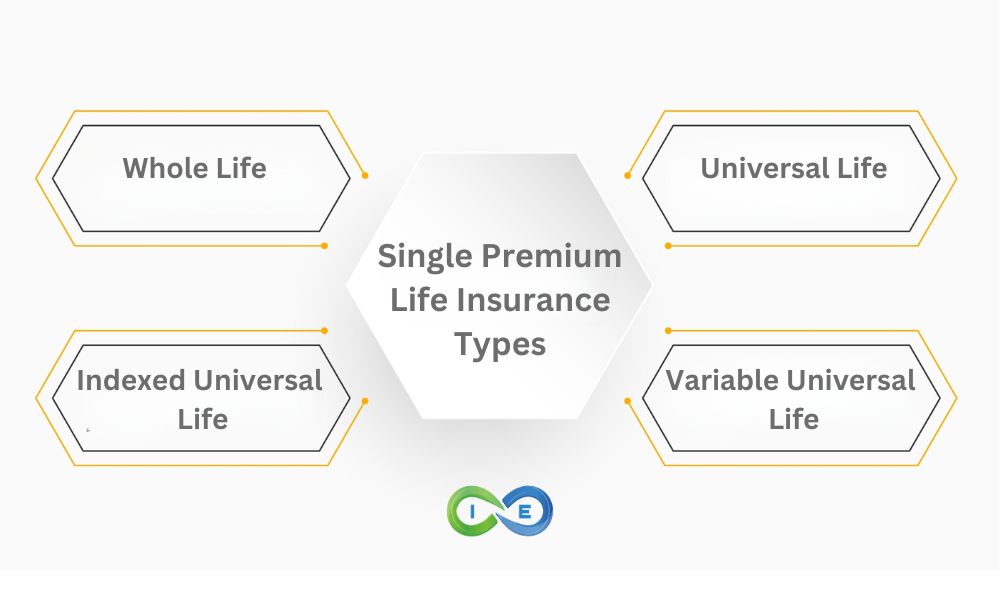Imagine securing lifetime coverage with just one payment. Single premium life insurance eliminates monthly premiums forever, offers tax-deferred growth potential, and provides an immediate leveraged death benefit—turning $100,000 into $500,000+ for your beneficiaries. But is this “set it and forget it” approach to life insurance the right strategy for your wealth and legacy planning?
Table of Contents
- What is Single Premium Life Insurance?
- Single Premium Life Insurance Types
- Single Premium Life Insurance Rates
- Modified Endowment Contract (MEC) Status
- Single Premium vs. Traditional Whole Life Insurance
- Why Choose Single Premium Life Insurance?
- Single Premium Life Insurance Alternatives
- Is Single Premium Life Insurance Right for You?
What is Single Premium Life Insurance?
In the world of life insurance, most policies, whether permanent life insurance such as whole life or universal life, or temporary life insurance such as term life, are paid for via monthly premium payments.
But Single Premium Life Insurance reflects a different approach to paying for life insurance. Rather than monthly premiums, a single premium life insurance policy allows you to pay one lump sum payment to fund the policy and secure a tax free death benefit, with no payments at all thereafter.
These single premium life insurance policies offer the peace of mind of knowing that your life insurance plan is fully funded from the get-go, alleviating any worries that a failure to pay premiums could cause your policy to lapse.
Because single premium life insurance policies require a single up-front payment to fund, they are not a good option for those who don’t have the available cash – typically a minimum of $10,000 or more.
Single premium life insurance policies do offer tax-deferred growth in the policy’s cash value account and provide a tax-free death benefit. Unfortunately the tax treatment of such policies is not as favorable as that of cash value life insurance policies that meet the requirements of the IRS seven pay rule.
Single Premium Life Insurance Types
The following are the different types of coverage available for single premium life insurance, along with each type’s risk profile.
| Policy Type | Features | Risk Level |
|---|---|---|
| Single Premium Whole Life | Guaranteed cash value growth based on interest and non-guaranteed dividends | Low Risk |
| Single Premium Universal Life | Guaranteed universal life provides different choices for coverage, up to certain ages, such as age 95, 100, 105, 110, and 120 | Low Risk |
| Single Premium Indexed Universal Life | Cash value growth tied to an underlying index, such as the S&P 500, subject to cap and participation rates. Includes a floor of 0-1% to protect from loss | Moderate Risk |
| Single Premium Variable Universal Life | Cash value growth tied to investment in sub accounts, similar to mutual funds. Unlimited upside potential but no floor, making principal vulnerable to loss | High Risk |
Single Premium Life Insurance Rates
The following single premium life insurance rates are for informational purposes only and must be qualified for. Rates are from A-rated carriers and above for a preferred plus male at the age shown. The dollar figure represents how much one-time payment is required to qualify for the corresponding initial death benefit.
| Age | $100,000 Death Benefit | $250,000 Death Benefit | $500,000 Death Benefit | $1,000,000 Death Benefit |
|---|---|---|---|---|
| 30 | $25,000 | $62,500 | $125,000 | $250,000 |
| 40 | $29,850 | $74,625 | $149,250 | $298,500 |
| 50 | $37,850 | $94,625 | $189,250 | $378,500 |
| 60 | $48,390 | $120,975 | $241,950 | $483,900 |
| 70 | $64,760 | $161,900 | $323,800 | $647,600 |
| 80 | $79,500 | $198,750 | $397,500 | $795,000 |
Single premium policies typically use a whole life chassis. A properly structured single pay whole life insurance policy provides guaranteed growth of the cash value account and death benefit. Since the sample rates above are whole life insurance quotes, the death benefit will increase over time.
THE ULTIMATE FREE DOWNLOAD
The Estate Planners Tactical Guide
Essential Legal Protection for Achievers

Modified Endowment Contract (MEC) Status
A critical aspect of single premium life insurance that every potential buyer should understand is that these policies are classified as Modified Endowment Contracts (MECs) under IRS rules.
MEC Taxation Rules
A life insurance contract which fails to pass a TAMRA 7-pay test is classified as a modified endowment contract due to cash contributions to the policy that exceed IRS limits. A major difference between MEC and non-MEC policies under IRC 7702 is the tax treatment of policy loans and withdrawals.
Policies classified as modified endowment contracts are subject to last in first out (LIFO) taxation from the IRS, meaning that taxes must typically be paid on any withdrawals from a cash account that has grown in value.
In addition, if you withdraw funds from a MEC policy prior to the attaining age 59½, penalties for early withdrawal apply, similar to the penalties you would pay for early 401k withdrawals.
As with 401k accounts, in certain cases you can withdraw funds from a modified endowment contract before age 59½ without penalty, for instance in the case of a 72T provision.
Traditional participating whole life insurance policies, on the other hand, allow for partial withdrawals tax and penalty-free up to the amount of your contributions to the policy, also known as your “basis” in the policy.
Understanding the 7-Pay Test
The 7-pay test, established by the Technical and Miscellaneous Revenue Act of 1988 (TAMRA), determines whether a life insurance policy is classified as a MEC. Under this test, a policy becomes a MEC if the premiums paid exceed the amount required to make the policy paid-up within seven years.
Since single premium policies are funded with one large payment upfront, they automatically fail the 7-pay test and are classified as MECs. This classification is important to understand because it affects how policy withdrawals and loans are taxed.
| Key Tax Differences: MEC vs. Non-MEC Life Insurance | |
|---|---|
| MEC (Single Premium) Policies | Non-MEC (Traditional) Policies |
| Last-In-First-Out (LIFO) taxation on withdrawals | First-In-First-Out (FIFO) taxation on withdrawals |
| Growth withdrawn first (taxable as ordinary income) | Basis (principal) withdrawn first (tax-free) |
| 10% penalty on withdrawals before age 59½ | No age-based penalties on withdrawals |
| Policy loans treated as distributions (potentially taxable) | Policy loans not considered taxable distributions |
| Death benefit remains income tax-free | Death benefit remains income tax-free |
Single Premium vs. Traditional Whole Life Insurance
Aside from tax treatment, MECs and traditional whole life insurance policies share many features.
Key Similarities
- A death benefit that is paid, typically free of taxes, to your beneficiary or beneficiaries
- Guaranteed growth of the cash value account
- If the policy is offered by a mutual life insurance company you can earn dividends
- Funds in the cash account grow tax-deferred
- Funds can be withdrawn via policy loans or partial withdrawals
- Protection from probate and privacy benefits
- Potential creditor protection depending on state laws
Important Differences
- Tax Treatment: Single Pay contracts are LIFO; Whole Life contracts are FIFO
- Early Withdrawal: Single Pay contracts withdrawals may incur a 10% penalty before age 59½; Whole life contracts have no such penalties
- Premium Structure: Single Pay requires one large payment; Whole Life allows for ongoing payments
- Liquidity Access: Single Pay has less favorable tax treatment when accessing cash value during lifetime
- Flexibility: Traditional policies offer more options for adjusting premiums over time
Single Premium Lump Sum vs Lump Sum High Cash Value Whole Life Insurance
The following webinar covers single premium vs lump sum whole life insurance. In the webinar, two different policies are illustrated, showing the viewer how a lump sum policy can offer similar (and often superior) results to a single premium life insurance policy.
Why Choose Single Premium Life Insurance?
Given the disadvantages of a MEC as compared to a non-MEC policy from a tax standpoint, why would you want to buy a single premium life insurance policy?
Peace of Mind
One major reason, as previously mentioned, is the convenience and peace of mind created by owning a fully funded life insurance policy, which eliminates any fear of your policy lapsing at some point due to failure to pay premiums.
Alternative Savings Vehicle
Another advantage of a single premium life insurance policy is the ability of these policies to act as an alternate savings vehicle offering returns that are competitive to other tax-favored investments.
A single premium life insurance policy, in effect, functions like an annuity contract that includes life insurance protection. As with a single premium immediate annuity, the most effective approach from a tax perspective is to avoid taking loans or withdrawals from such a policy until you reach age 59½. The same applies to any policy dividends, which may be taxable if taken in cash.
Potential Higher Returns
While traditional whole life policies also feature cash value account growth, a single premium whole life insurance policy may provide better performance in terms of internal rate of return as compared to a standard policy with the same level of insurance coverage. These policies typically can turn in a positive rate of return at least by the time the surrender charge has evaporated, if not sooner.
Tax Deferral Benefits
Single premium life insurance policies are often purchased by those who are seeking a policy that enables them to defer taxation and who don’t plan to take withdrawals from the policy, using it primarily for the tax free death benefit. If you plan to pass a significant sum on to your heirs or a charity, a modified endowment contract can be an efficient means of doing so.
| Estate Planning Benefits of Single Premium Life Insurance | |
|---|---|
| Tax-Free Death Benefit | Death benefits pass to beneficiaries income-tax free |
| Probate Avoidance | Policy proceeds bypass probate for named beneficiaries |
| Privacy | Insurance proceeds transfer privately, unlike assets in a will |
| Leverage | Single premium creates an immediate enhanced death benefit |
| Liquidity | Provides immediate liquidity for estate taxes and expenses |
Emergency Fund
Another reason for purchasing single premium life insurance is to gain the security of paid-up life insurance with cash value you can access in a pinch. Even if you have done a good job of setting aside money for retirement already, a single premium policy’s cash value can provide emergency funds if they are needed, albeit with potential tax consequences and penalties for early withdrawal.
Living Benefits
Additionally, the availability in recent years of single premium life insurance policies with accelerated death benefit riders that contain long-term care benefits has made these policies attractive as a long-term care (LTC) option in place of long-term care insurance.
Such long-term care riders, which are subject to underwriting approval and may be unavailable in some states, usually enable you access to part of the death benefit upon the occurrence of certain events.
Living Benefit Riders may include:
- Chronic illnesses which leave the insured unable to perform 2 or more activities of daily living, therefore requiring continuous care
- Accelerated death benefit allowing you to access the death benefit tax free upon diagnosis of terminal illness
- Specified medical conditions like cancer or potentially fatal cardiac disease
The ability to use a single premium life insurance as a combination life insurance policy/LTC rider solution with accelerated death benefits makes such policies truly flexible financial planning tools.
If you don’t require access to the LTC or accelerated death benefits such policies can offer, you can experience significant growth in your cash value account over time.
Whole life policies, especially dividend-paying policies offered by mutual life insurance companies have typically performed quite well when compared against bank savings accounts and CDs in recent years in terms of internal rate of return.
And if you experience medical emergencies or require long-term care, you can use a portion of the policy’s death benefit to deal with these conditions.
Furthermore, if you need access to your funds for any other reason, you can do so via a policy loan or partial withdrawal, as long as you are aware of the potential consequences in terms of taxes and penalties.
Financial Aid
Another advantage of a single premium life insurance policy is that it can help a child qualify for financial aid. Money held in an insurance policy, unlike funds contained in a 529 account, is not counted as part of the parents’ available assets when it comes to computing a child’s eligibility for financial aid.
THE ULTIMATE FREE DOWNLOAD
The Estate Planners Tactical Guide
Essential Legal Protection for Achievers

Single Premium Life Insurance Alternatives
If the various advantages of a single pay life insurance cited above don’t overcome its disadvantages, there are several ways to avoid owning a MEC without being required to make regular premium payments.
7-Pay Whole Life Insurance Policy
You can choose a 7-pay whole life insurance policy with an initial lump sum payment. A properly structured whole life insurance policy built for maximum cash value growth can be designed so that your initial premium payment is a larger payment. From there, you would have a premium schedule for 7 years total that would allow you to have the policy become fully paid-up life insurance, with no more payments due, but you would avoid the policy becoming a MEC.
A 1035 exchange from another insurance policy or an annuity:
A 1035 exchange may work in certain cases, but, in many cases, is not the optimal approach, given that it is often better to change an old insurance policy rather than replacing it in order to reduce or end the need to continue making payments on it.
However, in cases where you have built up cash value in a policy that is not right for your current circumstances, such an option enables you to convert that policy to a single premium life insurance policy that will not be classified as a MEC if the original policy was not considered a MEC.
Whole life non-MEC pre-paid premium policies:
It is possible to establish a non-MEC policy with one or two “pre-paid” payments. Part of the payment is kept in an account sponsored by the life insurance company that pays interest and is then added to the policy at a later time to prevent the policy being designated as a MEC.
Using a bridge loan to fund a whole life policy:
This approach involves placing a lump sum into a bridge loan contract, or several such contracts, that pay out cash flow on a monthly basis. This cash flow is then used to buy a non-MEC whole life insurance policy.
This strategy is subject to factors such as your age and health, among others, and offers the potential to provide you with greater growth and flexibility than would be the case if you simply used the cash to purchase a MEC.
Is Single Premium Life Insurance Right for You?
We know that we’ve discussed quite a bit here in this article about Single Premium Life Insurance. The good news is that we here at Insurance & Estates don’t expect you to now be an expert on all of it. All we hope is that you’re now more familiar with this type of life insurance policy and understand that it might be something you’ll want to consider for you and your family.
When evaluating whether a single premium policy is right for your situation, consider these key questions:
- Do you have a substantial lump sum available for the one-time premium payment?
- Is your primary goal to maximize the death benefit for estate planning purposes?
- Are you comfortable with the MEC tax treatment and potential penalties for accessing cash value before age 59½?
- Would you benefit from the living benefits features like chronic illness or long-term care protection?
- Have you explored alternative strategies like 7-pay whole life insurance that might offer better tax treatment?
The next step would be to give us a call and let us know what your goals are. This way we can help you determine what type of coverage is right for you. So, what are you waiting for? Give us a call today and see what Insurance & Estates can do for you!
Get Your Personalized Single Premium Life Insurance Analysis
Before deciding if a single premium policy is right for your financial strategy, get a customized analysis from our expert team. We’ll help you understand if this approach aligns with your wealth and legacy planning goals.
- ✓ Compare single premium options with alternatives like 7-pay whole life
- ✓ Understand the tax implications for your specific financial situation
- ✓ Explore strategies to maximize death benefit and living benefits
- ✓ Get answers to your specific questions about lump sum policies
Schedule your complimentary 30-minute strategy session today and take the first step toward informed life insurance planning.
Book Your Free Strategy Session
No obligation. No sales pressure. Just expert guidance to help you make the best decision for your financial future.







1 comment
Ronald D Cameron
Having problems with Selco credit union.did not know I had single life, I’ve seen 10 to 35 cent for single life coming off my credit card, anything or anyone can help with info. Selco seems to be on unlawful